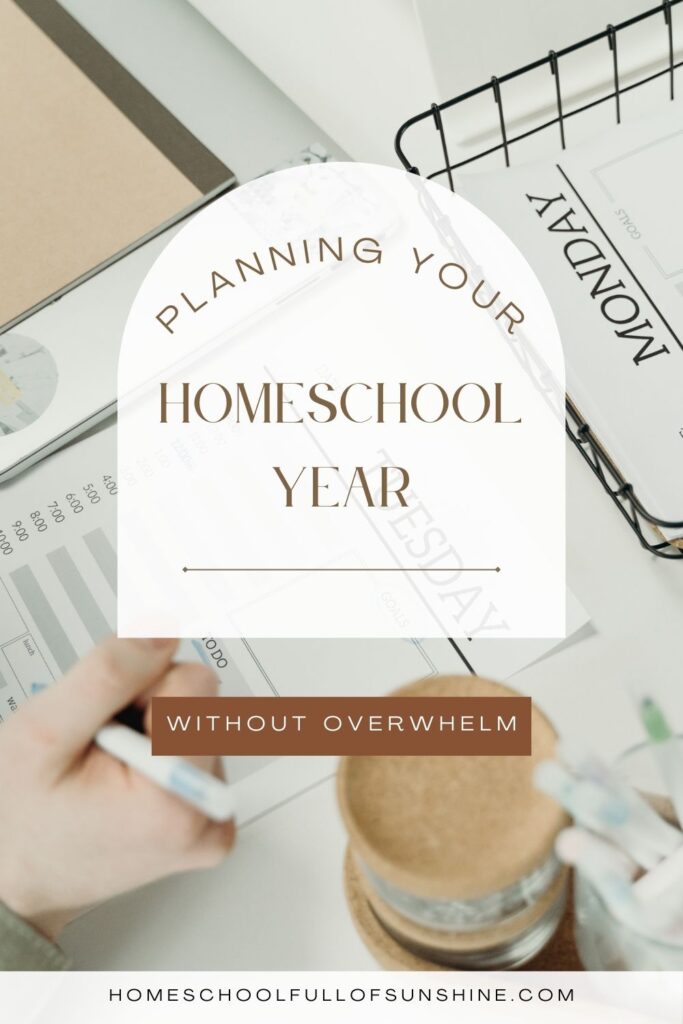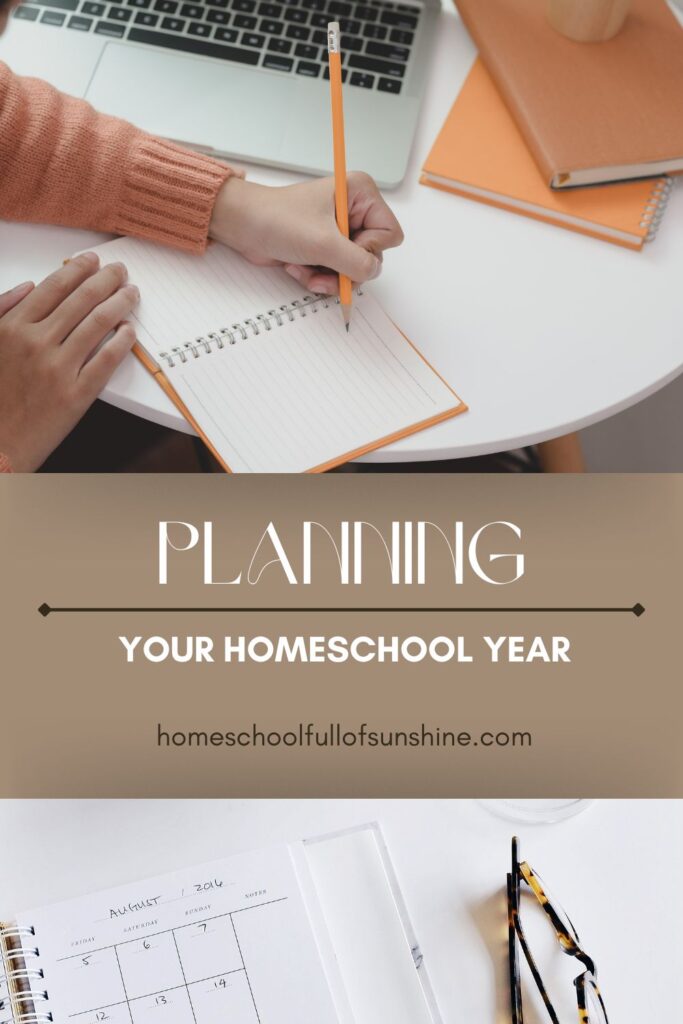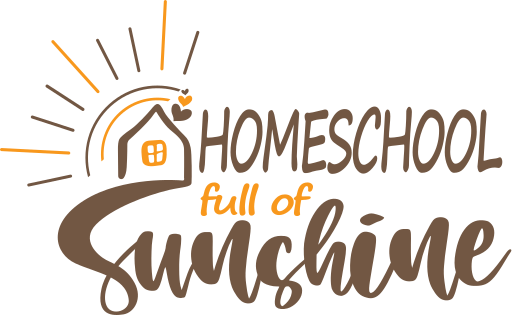
By: Marissa Gorski
Let’s talk planning!
Surely your Instagram feed must look like mine; full of beautifully set tables, intriguing book lists, and aesthetically styled school rooms. I always get that tingly new school-year feel this time of year. We’re still in the thick of summer and all the sweaty busyness that comes with it: camping and cottages and swimming lessons and splash pads. And yet I know fall is just around the corner! I won’t wish away our summer days but a large part of me longs for the rhythm fall brings, the structure of our days spending more time with our books, and the return of our co-ops and the girls beloved gymnastics.
We home educate all year long, taking breaks from book work when needed. Typically, that makes for a lighter summer, a long break in December, and a break when spring comes and the backyard calls us away. That being said, it also means for us that our core subjects (language, arts, and math) are typically ongoing. And so when I sit down to start planning our new school year, I am usually focusing on what Charlotte Mason refers to as the beauty subjects, along with our morning basket books, science, geography, world history, Canadian history, nature study, and any languages we hope to incorporate such as French or Spanish.

I find a good place to start planning if you’re new to home educating is by reflecting on your educational goals and perhaps aligning yourself with one or two educational philosophies. This can point you in the direction of curriculum choices and book lists that fit your style and meet the needs of your individual children. You might ask yourself, do I prefer an open and go curriculum for core subjects? A unit study approach? How many days at home can we dedicate to book work?
For us, we strive to incorporate lots of living books following a Charlotte Mason/Classical approach, but there are many educational philosophies out there and even quizzes online you can take to tell you your teaching/learning style. A few philosophies to consider:
- Charlotte Mason
- Classical
- Eclectic
- Unit Studies
- Waldorf
- Traditional school style
- Montessori
- Unschooling
Once you’ve narrowed down your home education style, you’ll likely be able to find a curriculum that suits you. For us, we use The Good and the Beautiful for language arts and math and find book lists to source books for our other subjects. This year, I am utilizing Ambleside Online’s free Charlotte Mason lists to source lots of books. Additionally, I always love checking out Blossom and Root, Brave Writer, Stories of Colour, The Well Trained Mind, Read Aloud Revival, and a variety of home educating accounts on social media for inspiration and book lists.
I am far from a tech-savvy mama, but something else I like to do is make up a blank spreadsheet with headings for each subject/category. Then, as the books I’ve sourced start arriving, I can input their titles in the spreadsheet as a way to keep track of what I hope for us to accomplish throughout the year. It can also be helpful to forecast your term/season. For example, a term one/fall forecast might focus on core subjects and feather in other subjects gradually if you’ve taken a summer break. If some of your book choices are seasonal, or if you follow a unit study approach, then a forecast can offer a nice way to order the books you plan on using. You can also plan on saving a unit study on snowflakes for the winter, seed germination for the spring, etc. I typically print out my spreadsheet and find that by visually seeing our list of books, it helps me remember which ones I want us to get to. Out of sight, out of mind is something I struggle with and when everything is shelved and out of my line of sight I tend to forget all about it!
I prefer a loose rhythm over a rigid schedule and so I often make up a second spreadsheet to plan out what our weeks will look like. This will be different for every family and will depend on how often you work on different subjects. With younger children, it may look like core subjects like language arts and math each day, and then once per week working through another subject (for example, science on Wednesdays, geography on Thursdays, etc.) I also include our extra curriculars, co-ops, and groups so that I may balance out the week taking into account that the days we need to be leaving the house will likely be days that our schoolwork is lighter. For us this year, I plan to have Monday as a day that we are home for the full day, and so that will be a day when I hope we can accomplish a bit more. Friday is when we spend the bulk of our day at our co-op so that becomes a day where I will just focus on core subjects and perhaps doing our morning basket.

Now a little note here on morning baskets (or sometimes referred to as morning time). This is a concept that is often associated with a Charlotte Mason education and I believe can be attributed to Cindy Rollins, author of Morning Time: A Liturgy of Love, Mere Motherhood, and more. Basically, having a routine morning time or a designated morning basket can be one way to get in some of the shorter subjects, and often the beauty subjects (like poetry, artist study, composer study, etc.). By starting your day with a morning basket, you can set a tone for your day. Maybe you light a candle and your children have breakfast while you read aloud. Maybe a few seasonal picture books are read to your toddler while older children begin on their handwriting or other independent work. Maybe, if you’re a busy family, you use it as a time to go over the day’s schedule as well. For us, I’ve included in my subject spreadsheet a category for morning time that includes biographies I hope for us to read, poetry, mythology, and other seasonal literature. Sometimes, seasonal literature could be focused around holidays like advent at Christmas time, lent at Easter, etc. Morning time can look however you want and is a reflection of your individual family values.
So you’ve chosen your core curriculum, you’ve found book lists to choose books from, you’ve ordered or placed library holds on the books you hope to use, and you’ve organized your week. Now what? Now, you take a deep breath, look at those beautiful children of yours and the home educating journey you get to share with them, and you hold it all as loosely as you can. We may strive to follow a rhythm and we may have a schedule we need to follow, but ultimately things will come up, interruptions will arise, and you may have to pivot. And that’s okay! As John Lennon once sang, “life is what happens to you while you’re busy making other plans”.
I hope this post has been helpful. Please comment below to share additional things that help you plan your homeschool year. If you’d like to connect further or are curious about our upcoming school year, feel free to find me on Instagram @marissa.at.home where I’m always happy to chat about all things home education! Happy planning mama, you’ve got this!


